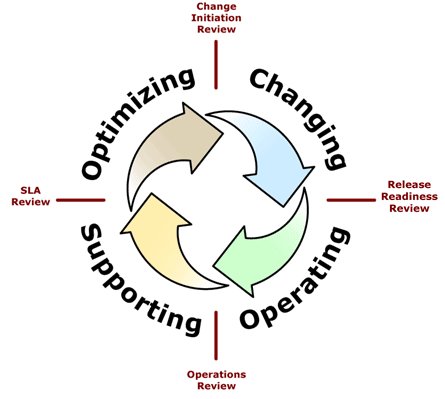The Microsoft Operations Framework (MOF) principles just discussed are instituted through the key components of the Process Model architecture, which are:
- Quadrants
- Operations management reviews
- Service management functions (SMFs)
Each of the quadrants has a unique mission of service that is accomplished through the implementation of underlying operational processes and activities contained in the SMFs. For example, in the Changing Quadrant, the underlying SMFs are:
- Change Management
- Configuration Management
- Release Management
Together, these functions comprehensively support the Changing Quadrant's mission of service, which is to effectively identify, approve, control, and release changes to the IT environment. The quadrants are represented in the following figure, showing quadrants and operations management reviews. It is important to note that, although the model implies a sequential nature from quadrant to quadrant, in most cases activities from all quadrants will be occurring simultaneously. Each of the quadrants is briefly described in the following sections.

Changing Quadrant
Once a release (which contains one or more changes) has been developed, tested, and is deemed ready for deployment (following MSF or another software development or project management approach), the MOF life cycle starts with a Release Readiness Review to determine if the release is ready and approved for deployment into the target environment. This review should not be the first time the release is evaluated in this manner but is rather a final review milestone prior to the actual deployment. Following a successful Release Readiness Review (that is, a "go" decision), rollout preparations are completed and the release is deployed and becomes fully functional in the target environment following the process guidance provided in the SMF guides that pertain to the Changing Quadrant. The use of these SMFs will provide a process and task road map to help ensure a successful deployment and rollout for managed releases. The post-implementation review then includes an evaluation to determine the degree of success and overall outcome of the deployed change(s) in the release. This is covered in greater detail later in this guide and extensively in each of the quadrant's SMF guides.
Operating Quadrant
Assuming a successful deployment, the release is now operational and the daily activities to run the system or application are being executed according to the operations guide for the system or service. The SMFs in this quadrant can be thought of as the typical data center activities, such as system administration, monitoring, batch processing, and so forth. These activities ensure the smooth and predictable operation of the release. It is crucial that, as the operations staff gains experience with a process, system, or application, the staff documents this experience and retains it in some sort of knowledge management system (or at least operations guide documents). Considering staff attrition rates and the fluctuating availability of qualified personnel, possession of such a knowledge base will enable the operations group to continue to provide consistent service levels to its customers. Having this knowledge and system documentation will also provide flexibility and added ease when workflow options for support and operations, such as outsourcing, are chosen.
Supporting Quadrant
The Supporting Quadrant contains the main SMFs required to provide ongoing support to the users of the IT service solutions. As with any process, system, application, or service, problems and issues inevitably will arise when operations begins. The support and operations staff must identify, assign, and resolve incidents and problems quickly to meet the requirements set forth in the service level agreements. The underlying SMFs in this quadrant include an integrated set of reactive and proactive resolution functions, which include service desk, incident management, and problem management.
Optimizing Quadrant
MOF recognizes that running IT operations successfully is an imperative to achieving business success in the competitive marketplace. The Optimizing Quadrant specifically addresses this idea by focusing on three fundamental elements of operations:
- Business-focused service level management
- IT cost management
- Planning for improvements and change
As noted earlier, the mission of service for this quadrant is to reduce costs while maintaining or improving service levels. This is accomplished through the management and negotiation of service levels and the evaluation of several key operational metrics in the managed environment. With a thorough evaluation and subsequent understanding of these operational attributes, the IT staff moves from simply "running" a system to proactively managing a service solution. Planning is a key focus of this quadrant. It is important that the IT organization looks as far as possible into the future in order to align with ever-changing business priorities-for example, in planning growth in areas such as capacity or anticipating changes in the labor pool and predicting its effects on workforce management. Placing the MOF quadrants into the logical order described here and applying the concept of iteration forms a spiral life cycle that can be applied to a specific application, a data center, or an entire operations environment with multiple data centers, including outsourced operations and hosted applications.